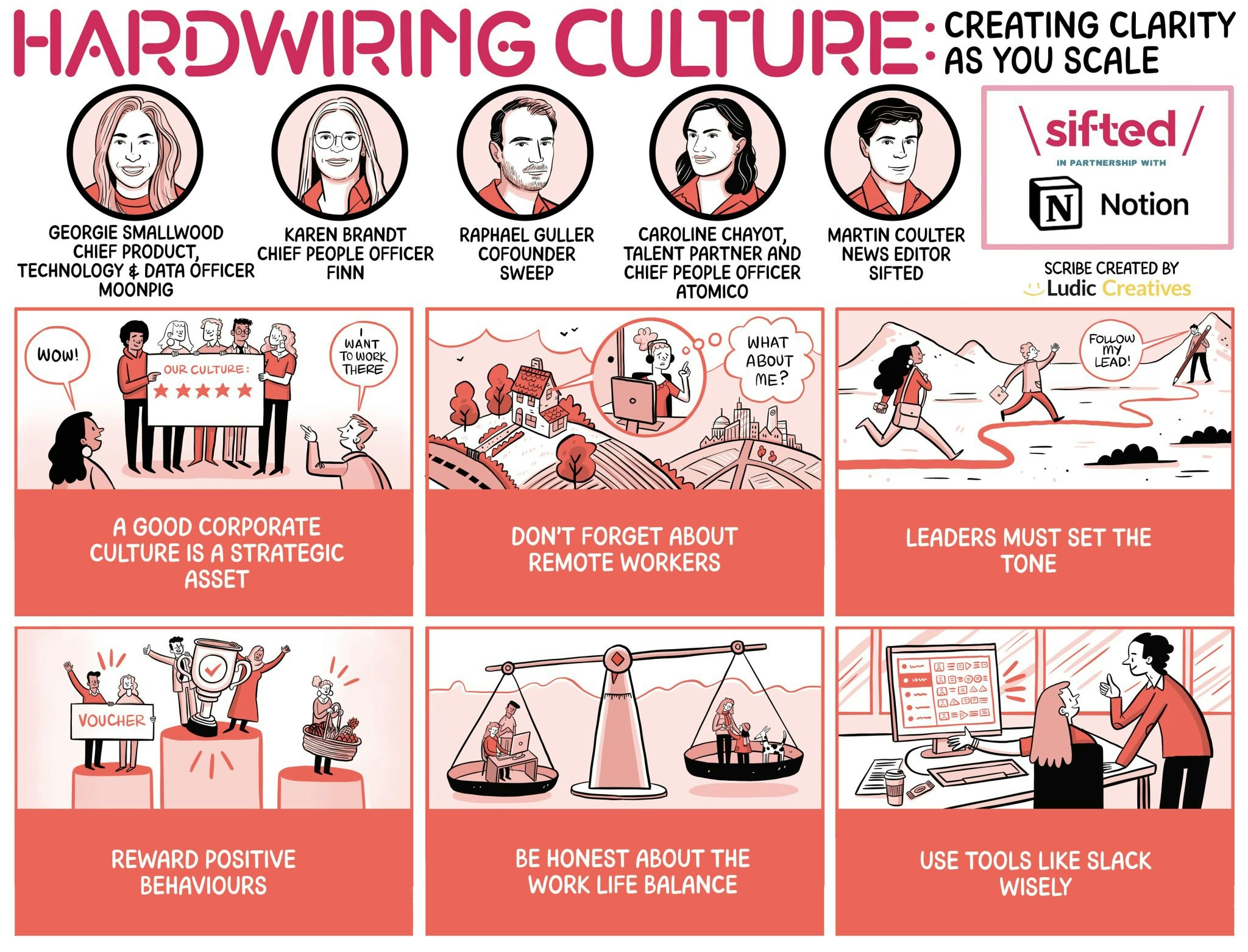For European VC giant Atomico, “culture is everything.” The firm's chief people officer Caroline Chayot says it encompasses everything from who they hire to who they let go, acting as a north star.
But what does corporate culture actually mean, and how do we measure it?
In our latest Sifted Talks, we dove into the complexities of building company culture, with a panel of expertsdiscussing everything from tracking culture metrics to fostering the right behaviours.
Our speakers were:
- Georgie Smallwood, chief product, tech and data officer at greeting cards company Moonpig
- Raphael Güller, cofounder of carbon accounting startup Sweep
- Karen Brandt, people officer at car subscription startup Finn
- Caroline Chayot, chief people officer at VC firm Atomico
Here are the key takeaways:

1/ A good corporate culture is a strategic asset
For Smallwood, corporate culture is the “collective expression of how people work together,” how decisions are made and how individuals treat one another. It’s intangible, the invisible architecture of an organisation.
At Finn, Brandt described corporate culture as a “strategic asset.” To refine it, the leadership team worked backwards from the company’s goals, asking: What does our culture need to look like for us to succeed?
When you’re tested and have to make tough decisions, when it’s not obvious what the choice is, you go back to your principles and that’s when culture comes alive — Caroline Chayot, Atomico
2/ Don’t forget about remote workers
Historically culture has been defined and refined in the office. But as remote work becomes more popular, how do companies make sure culture isn’t left behind?
At Atomico, remote work had been the norm, but the company has since moved to a four-day-a-week office model. The decision was driven by the need to preserve company culture and to recognise how people learn — particularly in the VC sector, where mentorship plays a crucial role.
Sweep has embraced a hybrid model, aiming to hire talent globally and leverage the benefits of a diverse workforce. Finn takes a similar approach, but has to ensure new hires stay connected to the company culture.
Reflecting on a previous role, Smallwood said she had once gone to great lengths to build a strong team culture, but warned that when one team’s culture differs too much from the rest of the organisation, it can create major disruption.
You need structure around working practices, but the key is having lightweight but clear rules at the top that can cascade through the organisation. — Georgie Smallwood, Moonpig
3/ Leaders must set the tone
Güller at Sweep admitted he had once spent too much time trying to change behaviours that weren’t a natural fit, instead of focusing on amplifying the right behaviours already present. He found it far more effective to reward and grow the positive behaviours that align with culture.
Chayot said many small businesses make this mistake: “Introducing too many processes early is a culture killer.” Instead, leaders must set the tone in how they show up and how they give feedback.
“You don’t always need pulse surveys or formal mechanisms,” she said, adding much of this can be done verbally. “What really matters is: do employees feel heard? Do they understand what’s expected of them? Does leadership act on feedback? Crucially, don’t enforce rules on the people who are already aligned.”
You can be a high-performance company by aiming high and setting ambitious goals, but to make it work, you have to prioritise rigorously, set clear objectives and ensure people are working towards them — Karen Brandt, Finn
4/ Be honest about the work life balance
Sometimes companies that drive massive revenues are accused of having a toxic culture. But how can you balance high performance with an employee-friendly environment?
Smallwood called the assumption that high-performance cultures must come at the expense of working conditions both flawed and damaging.
Güller highlighted the frequent gap between what companies say about their culture and what employees experience. For example, a business might claim to prioritise work-life balance, but if the founder and leadership team are working until 11pm and sending emails at 3am, the reality on the ground is different.
Chayot added that founders should be unapologetic about the culture. She cited a client whose business was at Series B stage where the leadership openly describes themselves as workaholics, with no boundaries between work and life.
A lot of candidates select out and that, to me, is success because they’re not selling something they’re not. You agree, you disagree. It’s up to you whether it fits or not, but at least it’s unapologetic — and it’s working for them so far — Chayot
5/ Use tools like Slack wisely
Reflecting on his experience at Sweep, Güller explained how he championed Slack as a core element of remote work culture — but as the business scaled, it became a distraction. His takeaway? Tools should always serve a clear, defined purpose.
Brandt agreed, adding that while tools like Slack are useful for internal communication and documentation, what truly matters is experiencing and living the culture day to day. In-person moments are critical for bringing that culture to life, especially for those who aren’t regularly in the office.
At Twitter, we had users come in every Friday to talk to us, and that reminds you of the power of the platform. So think creatively about how to reinforce alignment to vision, mission and culture because there are lots of ways to do that — Brandt
Like this and want more? Watch the full Sifted Talks here:





